Kumar Vijay Mishra
United States CCDC Army Research Laboratory
Twisting Signals for Joint Radar-Communications: An OAM Vortex Beam Approach
Sep 19, 2025Abstract:Orbital angular momentum (OAM) technology has attracted much research interest in recent years because of its characteristic helical phase front twisting around the propagation axis and natural orthogonality among different OAM states to encode more degrees of freedom than classical planar beams. Leveraging upon these features, OAM technique has been applied to wireless communication systems to enhance spectral efficiency and radar systems to distinguish spatial targets without beam scanning. Leveraging upon these unique properties, we propose an OAM-based millimeter-wave joint radar-communications (JRC) system comprising a bi-static automotive radar and vehicle-to-vehicle (V2V) communications. Different from existing uniform circular array (UCA) based OAM systems where each element is an isotropic antenna, an OAM spatial modulation scheme utilizing a uniform linear array (ULA) is adopted with each element being a traveling-wave antenna, producing multiple Laguerre-Gaussian (LG) vortex beams simultaneously. Specifically, we first build a novel bi-static automotive OAM-JRC model that embeds communication messages in a radar signal, following which a target position and velocity parameters estimation algorithm is designed with only radar frames. Then, an OAM-based mode-division multiplexing (MDM) strategy between radar and JRC frames is presented to ensure the JRC parameters identifiability and recovery. Furthermore, we analyze the performance of the JRC system through deriving recovery guarantees and Cram\'er-Rao lower bound (CRLB) of radar target parameters and evaluating the bit error rate (BER) of communication, respectively. Our numerical experiments validate the effectiveness of the proposed OAM-based JRC system and parameter estimation method.
Coherent Source Enumeration with Compact ULAs
Apr 27, 2025

Abstract:Source enumeration typically relies on subspace-based techniques that require accurate separation of signal and noise subspaces. However, prior works do not address coherent sources in small uniform linear arrays, where ambiguities arise in the spatial spectrum. We address this by decomposing the forward-backward smoothed covariance matrix into a sum of a rank-constrained Toeplitz matrix and a diagonal matrix with non-negative entries representing the signal and noise subspace, respectively. We solve the resulting non-convex optimization problem by proposing Toeplitz approach for rank-based target estimation (TARgEt) that employs the alternating direction method of multipliers. Numerical results on both synthetic and real-world datasets demonstrate the effectiveness and robustness of TARgEt over a recent subspace matching method and a related covariance matrix reconstruction approach.
CLuP-Based Dual-Deconvolution in Automotive ISAC Scenarios
Mar 28, 2025Abstract:Accurate target parameter estimation of range, velocity, and angle is essential for vehicle safety in advanced driver assistance systems (ADAS) and autonomous vehicles. To enable spectrum sharing, ADAS may employ integrated sensing and communications (ISAC). This paper examines a dual-deconvolution automotive ISAC scenario where the radar waveform is known but the propagation channel is not, while in the communications domain, the channel is known but the transmitted message is not. Conventional maximum likelihood (ML) estimation for automotive target parameters is computationally demanding. To address this, we propose a low-complexity approach using the controlled loosening-up (CLuP) algorithm, which employs iterative refinement for efficient separation and estimation of radar targets. We achieve this through a nuclear norm restriction that stabilizes the problem. Numerical experiments demonstrate the robustness of this approach under high-mobility and noisy automotive environments, highlighting CLuP's potential as a scalable, real-time solution for ISAC in future vehicular networks.
WaveMax: Radar Waveform Design via Convex Maximization of FrFT Phase Retrieval
Jan 24, 2025Abstract:The ambiguity function (AF) is a critical tool in radar waveform design, representing the two-dimensional correlation between a transmitted signal and its time-delayed, frequency-shifted version. Obtaining a radar signal to match a specified AF magnitude is a bi-variate variant of the well-known phase retrieval problem. Prior approaches to this problem were either limited to a few classes of waveforms or lacked a computable procedure to estimate the signal. Our recent work provided a framework for solving this problem for both band- and time-limited signals using non-convex optimization. In this paper, we introduce a novel approach WaveMax that formulates waveform recovery as a convex optimization problem by relying on the fractional Fourier transform (FrFT)-based AF. We exploit the fact that AF of the FrFT of the original signal is equivalent to a rotation of the original AF. In particular, we reconstruct the radar signal by solving a low-rank minimization problem, which approximates the waveform using the leading eigenvector of a matrix derived from the AF. Our theoretical analysis shows that unique waveform reconstruction is achievable with a sample size no more than three times the signal frequencies or time samples. Numerical experiments validate the efficacy of WaveMax in recovering signals from noiseless and noisy AF, including scenarios with randomly and uniformly sampled sparse data.
Deep Learning Model-Based Channel Estimation for THz Band Massive MIMO with RF Impairments
Sep 24, 2024Abstract:THz band enabled large scale massive MIMO (M-MIMO) is considered as a key enabler for the 6G technology, given its enormous bandwidth and for its low latency connectivity. In the large-scale M-MIMO configuration, enlarged array aperture and small wavelengths of THz results in an amalgamation of both far field and near field paths, which makes tasks such as channel estimation for THz M-MIMO highly challenging. Moreover, at the THz transceiver, radio frequency (RF) impairments such as phase noise (PN) of the analog devices also leads to degradation in channel estimation performance. Classical estimators as well as traditional deep learning (DL) based algorithms struggle to maintain their robustness when performing for large scale antenna arrays i.e., M-MIMO, and when RF impairments are considered for practical usage. To effectively address this issue, it is crucial to utilize a neural network (NN) that has the ability to study the behaviors of the channel and RF impairment correlations, such as a recurrent neural network (RNN). The RF impairments act as sequential noise data which is subsequently incorporated with the channel data, leading to choose a specific type of RNN known as bidirectional long short-term memory (BiLSTM) which is followed by gated recurrent units (GRU) to process the sequential data. Simulation results demonstrate that our proposed model outperforms other benchmark approaches at various signal-to-noise ratio (SNR) levels.
Near-Field Signal Processing: Unleashing the Power of Proximity
Aug 21, 2024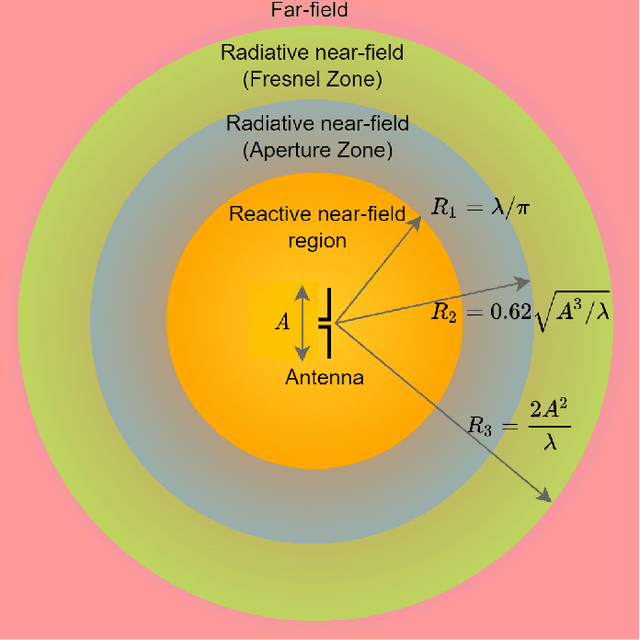
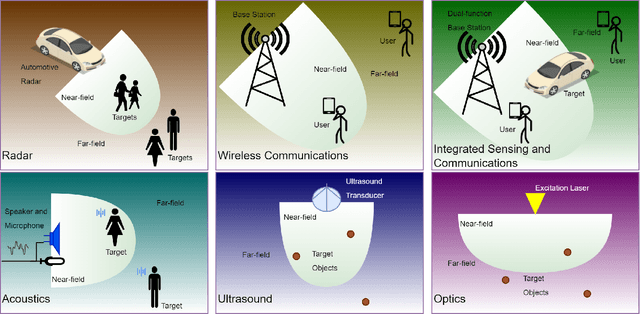
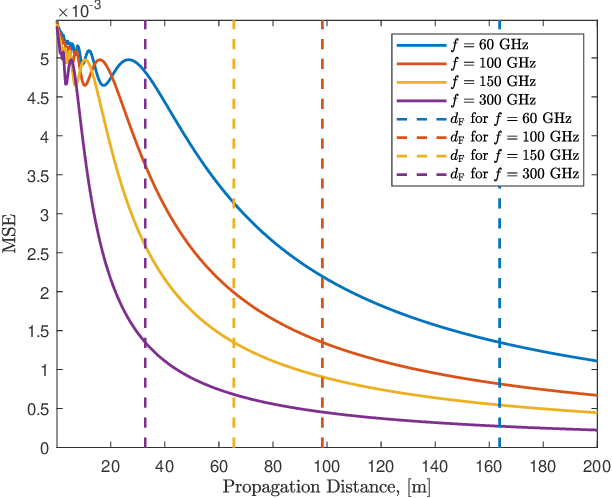
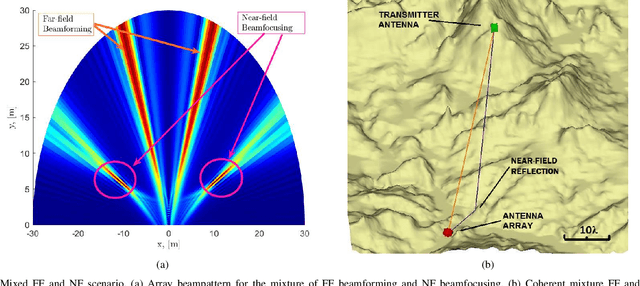
Abstract:After nearly a century of specialized applications in optics, remote sensing, and acoustics, the near-field (NF) electromagnetic propagation zone is experiencing a resurgence in research interest. This renewed attention is fueled by the emergence of promising applications in various fields such as wireless communications, holography, medical imaging, and quantum-inspired systems. Signal processing within NF sensing and wireless communications environments entails addressing issues related to extended scatterers, range-dependent beampatterns, spherical wavefronts, mutual coupling effects, and the presence of both reactive and radiative fields. Recent investigations have focused on these aspects in the context of extremely large arrays and wide bandwidths, giving rise to novel challenges in channel estimation, beamforming, beam training, sensing, and localization. While NF optics has a longstanding history, advancements in NF phase retrieval techniques and their applications have lately garnered significant research attention. Similarly, utilizing NF localization with acoustic arrays represents a contemporary extension of established principles in NF acoustic array signal processing. This article aims to provide an overview of state-of-the-art signal processing techniques within the NF domain, offering a comprehensive perspective on recent advances in diverse applications.
CoFAR Clutter Estimation using Covariance-Free Bayesian Learning
Aug 12, 2024Abstract:A cognitive fully adaptive radar (CoFAR) adapts its behavior on its own within a short period of time in response to changes in the target environment. For the CoFAR to function properly, it is critical to understand its operating environment through estimation of the clutter channel impulse response (CCIR). In general, CCIR is sparse but prior works either ignore it or estimate the CCIR by imposing sparsity as an explicit constraint in their optimization problem. In this paper, contrary to these studies, we develop covariance-free Bayesian learning (CoFBL) techniques for estimating sparse CCIR in a CoFAR system. In particular, we consider a multiple measurement vector scenario and estimate a simultaneously sparse (row sparse) CCIR matrix. Our CoFBL framework reduces the complexity of conventional sparse Bayesian learning through the use of the diagonal element estimation rule and conjugate gradient descent algorithm. We show that the framework is applicable to various forms of CCIR sparsity models: group, joint, and joint-cum-group. We evaluate our method through numerical experiments on a data set generated using RFView, a high-fidelity modeling and simulation tool. We derive Bayesian Cram\'{e}r-Rao bounds for the various considered scenarios to benchmark the performance of our algorithms. Our results demonstrate that the proposed CoFBL-based approaches perform better than the existing popular approaches such as multiple focal underdetermined system solver and simultaneous orthogonal matching pursuit.
Inverse Particle and Ensemble Kalman Filters
Jul 23, 2024Abstract:In cognitive systems, recent emphasis has been placed on studying cognitive processes of the subject whose behavior was the primary focus of the system's cognitive response. This approach, known as inverse cognition, arises in counter-adversarial applications and has motivated the development of inverse Bayesian filters. In this context, a cognitive adversary, such as a radar, uses a forward Bayesian filter to track its target of interest. An inverse filter is then employed to infer adversary's estimate of target's or defender's state. Previous studies have addressed this inverse filtering problem by introducing methods like inverse Kalman filter (I-KF), inverse extended KF (I-EKF), and inverse unscented KF (I-UKF). However, these inverse filters assume additive Gaussian noises and/or rely on local approximations of non-linear dynamics at the state estimates, limiting their practical application. Contrarily, this paper adopts a global filtering approach and develops an inverse particle filter (I-PF). The particle filter framework employs Monte Carlo (MC) methods to approximate arbitrary posterior distributions. Moreover, under mild system-level conditions, the proposed I-PF demonstrates convergence to the optimal inverse filter. Additionally, we explore MC techniques to approximate Gaussian posteriors and introduce inverse Gaussian PF (I-GPF) and inverse ensemble KF (I-EnKF). Our I-GPF and I-EnKF can efficiently handle non-Gaussian noises with suitable modifications. Additionally, we propose the differentiable I-PF, differentiable I-EnKF, and reproducing kernel Hilbert space-based EnKF (RKHS-EnKF) methods to address scenarios where system information is unknown to defender. Using recursive Cram\'er-Rao lower bound and non-credibility index (NCI), our numerical experiments for different applications demonstrate the estimation performance and time complexity of the proposed filters.
CoSTAP: Clutter Suppression in Co-Pulsing FDA-STAP
Jul 14, 2024



Abstract:Range-dependent clutter suppression poses significant challenges in airborne frequency diverse array (FDA) radar, where resolving range ambiguity is particularly difficult. Traditional space-time adaptive processing (STAP) techniques used for clutter mitigation in FDA radars operate in the physical domain defined by first-order statistics. In this paper, unlike conventional airborne uniform FDA, we introduce a space-time-range adaptive processing (STRAP) method to exploit second-order statistics for clutter suppression in the newly proposed co-pulsing FDA radar. This approach utilizes co-prime frequency offsets (FOs) across the elements of a co-prime array, with each element transmitting at a non-uniform co-prime pulse repetition interval (C-Cube). By incorporating second-order statistics from the co-array domain, the co-pulsing STRAP or CoSTAP benefits from increased degrees of freedom (DoFs) and low computational cost while maintaining strong clutter suppression capabilities. However, this approach also introduces significant computational burdens in the coarray domain. To address this, we propose an approximate method for three-dimensional (3-D) clutter subspace estimation using discrete prolate spheroidal sequences (DPSS) to balance clutter suppression performance and computational cost. We first develop a 3-D clutter rank evaluation criterion to exploit the geometry of 3-D clutter in a general scenario. Following this, we present a clutter subspace rejection method to mitigate the effects of interference such as jammer. Compared to existing FDA-STAP algorithms, our proposed CoSTAP method offers superior clutter suppression performance, lower computational complexity, and enhanced robustness to interference. Numerical experiments validate the effectiveness and advantages of our method.
The Curse of Beam-Squint in ISAC: Causes, Implications, and Mitigation Strategies
Jun 05, 2024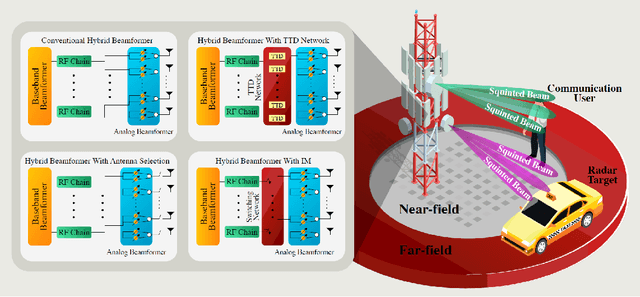
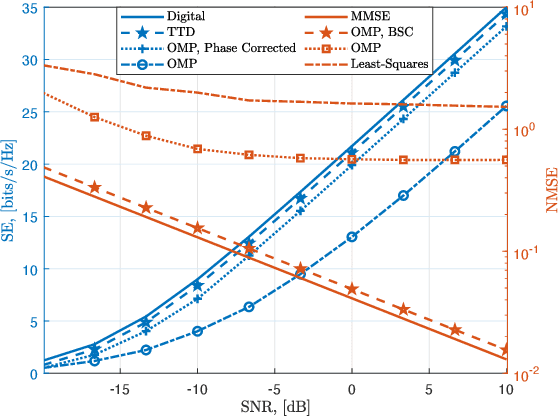
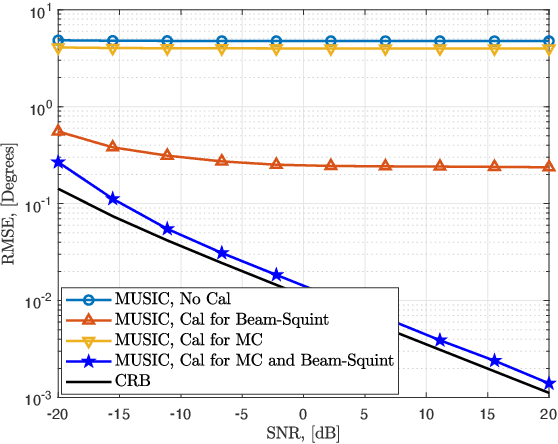
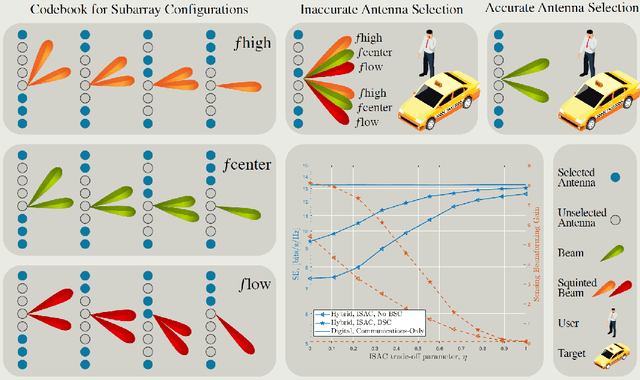
Abstract:Integrated sensing and communications (ISAC) has emerged as a means to efficiently utilize spectrum and thereby save cost and power. At the higher end of the spectrum, ISAC systems operate at wideband using large antenna arrays to meet the stringent demands for high-resolution sensing and enhanced communications capacity. However, the wideband implementation entails beam-squint, that is, deviations in the generated beam directions because of the narrowband assumption in the analog components. This causes significant degradation in the communications capacity, target detection, and parameter estimation. This article presents the design challenges caused by beam-squint and its mitigation in ISAC systems. In this context, we also discuss several ISAC design perspectives including far-/near-field beamforming, channel/direction estimation, sparse array design, and index modulation. There are also several research opportunities in waveform design, beam training, and array processing to adequately address beam-squint in ISAC.
 Add to Chrome
Add to Chrome Add to Firefox
Add to Firefox Add to Edge
Add to Edge